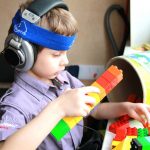“Why is it so difficult for Karen to get to a place of calm so she can go to bed at night? We have tried everything and we are exhausted as a family. We know she understands what the expectation is; yet it is virtually impossible for her to get to this point herself. Sometimes she falls asleep from pure exhaustion and we can see how tired she becomes, but she simply cannot turn off the “switch”. Most nights, simply for the sake of all of us, she comes to sleep with us in our bedroom. Honestly, Maude, that is the only way any of us can get rest, even though we know she is old enough to sleep on her own. On occasions when she does fall asleep at a reasonable time, she will wake up in the middle of the night and either yell for us or come to our room and sleep with us.” We can hear the frustration of this family story and know this resonates with so many other families.
Sleep is a wondrous thing. It renews us spirit, flesh and mind and provides a lovely place from which we can attack the next morning’s chores and activities. When this is not possible, we find ourselves running around on pure adrenalin, more stressed than we ought to be, and the energy for working and processing through other needs is simply not available. Children with sleep difficulties simply do not have the same attention to task than their peers the next day and is literally using the available energy to cope with the stress of feeling tired rather than using their energy for the learning process. It is quite remarkable to see how some children cope within these circumstances as they show much more resilience than their behavior gets credit for.
The first step in a sleep-deprived situation is to have it checked out medically and make sure your child does not struggle with conditions such as sleep apnea, breathing regulation or nighttime reflux. This is a condition wherein stomach acid flows up into the esophagus causing discomfort in the chest and throat area and cause waking up in the early hours of the morning. It does not always have to come up in the throat, but could stay in chest area, making it very difficult to determine as an issue.
But if the medical investigation proves a healthy system, the next step would be to check your child’s regulatory or modulation pattern. Sensory modulation is an inability for two major nervous system pathways: Sympathetic (arousal) and Parasympathetic (inhibition) to come together at a “just right” place for an even keel performance in arousal and attention. Think about that first cup of coffee in the morning and what it does for you to wake up. You know what your system needs to get to the “just right” place. Children with modulation difficulties do not. They know they have to get down to rest, but try as they may, that point of calming is ever illusive, causing even more distress and fatigue. In some families this is further exacerbated by the child’s anticipation of bedtime and her inner “knowing” that she is going to seek for this control, but feel hopeless to accomplish it. So just the very mention of bedtime sets this anxious cycle in motion again for yet another night.
Sensory modulation can look different in different children and there is no “one size fits all” approach. Some kids are calmed by a warm bath before bedtime; others are over-aroused by the prospect of a bath. It is best to work with an experienced occupational therapist to determine your child’s particular profile and work on specific ways applicable to your child. Some starter ideas for you:
- Regular bedtime routine No TV or ipad in the bed before expecting to sleep. It actually alerts the brain.
- Dimming the lights in child’s environment an hour before bedtime.
- Soft calming music an hour before bedtime in the child’s hearing vicinity.
- Spending time with the child with joint attention to a calming activity within the hour before bedtime.
- Reading a story and having quiet family time together.
- Warm baths are good for some children.
- Some families find relief from adding a spoon or two of Epsom salts to the bath.
- The smell of lavender is calming to the nervous system, whereas mint is not.
- Ensure the right texture blanket / sheet on child’s bed, well as the bedclothes.
- Also try tight clothing, such as spandex sports clothes that fit snugly and tight on the body.
- Heavier bed blankets might be a good idea for some even in the heat of summer. There are weighted blankets available commercially.
- A night light might work for some.
- I’m not in favor of white noise, but more pink noise.
As an intervention, we frequently like to train families in a tactile integration massage technique that really works well. The calming touch of the parent’s hands going over the body in an organized way that stimulates the nervous system to the point of calm proves to be a great modulator as well as an emotionally connected time between parent and child.
Just the very mention of bedtime sets this anxious cycle in motion again for yet another night.
We also must consider the emotional connection to sleep. Many children feel anxious about separating from the parent for sleep, as there is an innate worry or fear that they will “lose” their anchor if they do. Emotional development requires that we separate from our parent in order to individuate and some children simply cannot get ready for this phase of autonomy and self-sufficiency. They might be having a difficult time working through fears and worries and might be stuck developmentally. Or they might be having difficulty working on the difference between fantasy and reality and therefore their anxious experiences become far larger than their reality. The child might simply feel threatened by a younger sibling taking her mom’s attention away from her, another developmental milestone to conquer. No behavior technique can replace the growth of emotional understanding that has to accompany the ability of the child to separate. The child needs a safe place of understanding to play out these fears and worries, so she can move on.
Getting sufficient sleep is important and all of Karen’s adaptive skills will be impacted, as she fights to stay alert and available and misses other important information. This topic is far more comprehensive than this blog allows, but hopefully it is helpful in getting started in the right direction.








